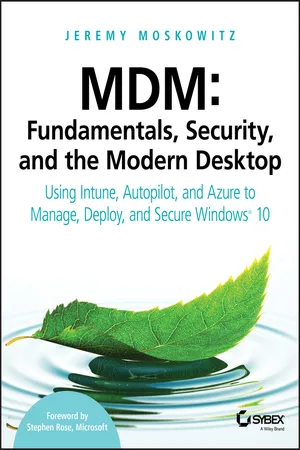
MDM: Fundamentals, Security, and the Modern Desktop
Using Intune, Autopilot, and Azure to Manage, Deploy, and Secure Windows 10
- English
- ePUB (mobile friendly)
- Available on iOS & Android
MDM: Fundamentals, Security, and the Modern Desktop
Using Intune, Autopilot, and Azure to Manage, Deploy, and Secure Windows 10
About this book
The first major book on MDM written by Group Policy and Enterprise Mobility MVP and renowned expert, Jeremy Moskowitz!
With Windows 10, organizations can create a consistent set of configurations across the modern enterprise desktop—for PCs, tablets, and phones—through the common Mobile Device Management (MDM) layer. MDM gives organizations a way to configure settings that achieve their administrative intent without exposing every possible setting. One benefit of MDM is that it enables organizations to apply broader privacy, security, and application management settings through lighter and more efficient tools. MDM also allows organizations to target Internet-connected devices to manage policies without using Group Policy (GP) that requires on-premises domain-joined devices. This makes MDM the best choice for devices that are constantly on the go.
With Microsoft making this shift to using Mobile Device Management (MDM), a cloud-based policy-management system, IT professionals need to know how to do similar tasks they do with Group Policy, but now using MDM, with its differences and pitfalls.
- What is MDM (and how is it different than GP)
- Setup Azure AD and MDM Auto-Enrollment
- New PC Rollouts and Remote Refreshes: Autopilot and Configuration Designer
- Enterprise State Roaming and OneDrive Documents Roaming
Renowned expert and Microsoft Group Policy and Enterprise Mobility MVP Jeremy Moskowitz teaches you MDM fundamentals, essential troubleshooting techniques, and how to manage your enterprise desktops.
Frequently asked questions
- Essential is ideal for learners and professionals who enjoy exploring a wide range of subjects. Access the Essential Library with 800,000+ trusted titles and best-sellers across business, personal growth, and the humanities. Includes unlimited reading time and Standard Read Aloud voice.
- Complete: Perfect for advanced learners and researchers needing full, unrestricted access. Unlock 1.4M+ books across hundreds of subjects, including academic and specialized titles. The Complete Plan also includes advanced features like Premium Read Aloud and Research Assistant.
Please note we cannot support devices running on iOS 13 and Android 7 or earlier. Learn more about using the app.
Information
Chapter 1
Enterprise Mobility and MDM Essentials

Getting Ready to Use This Book
- Azure AD (free) or Azure AD Premium (preferred for this book). And, if you have Office 365, you already have Azure AD.
- An MDM service, like Microsoft Intune, VMware Workspace ONE, or MobileIron. Most of the main services have 30 day (or longer) evaluations.
- DC01 (I recommend Server 2019 or Server 2016.)
WIN10Computer.fabrikam.comjoined to DC01. If you have other machines joined toFabrikam.comtoo, that would be okay and likely useful as well.- WIN10-NDJ-1 not domain joined at all
- WIN10-NDJ-2 also not domain joined at all
https://www.policypak.com/video/policypak-cloud-how-to-create-a-dc-for-editing-purposes.htmlFabrikam.com.
https://blogs.msdn.microsoft.com/oldnewthing/20061013-05/?p=29393Why the Need for MDM
MDMandGpanswers.com at:https://www.GPanswers.com/blogs/view-blog/the-why-group-policy-is-not-dead-manifestohttps://docs.microsoft.com/en-us/windows/client-management/manage-windows-10-in-your-organization-modern-managementTable of contents
- Cover
- Title Page
- Copyright
- XXXXXXXXXXXXX
- Acknowledgments
- About the Author
- Foreword
- Introduction
- Chapter 1 Enterprise Mobility and MDM Essentials
- Chapter 2 Set Up Azure AD and MDM
- Chapter 3 MDM Profiles, Policies, and Groups
- Chapter 4 Co-Management and Co-Policy Management
- Chapter 5 MDM Migration and MDM Troubleshooting
- Chapter 6 Deploying Software and Scripts
- Chapter 7 Enterprise State Roaming and OneDrive for Business
- Chapter 8 Rollouts and Refreshes with Configuration Designer and Autopilot
- Chapter 9 Windows 10 Health and Happiness: Servicing, Readiness, Analytics, and Compliance
- Chapter 10 Security with Baselines, BitLocker, AppLocker, and Conditional Access
- Chapter 11 MDM Add-On Tools: Free and Pay
- Index
- End User License Agreement